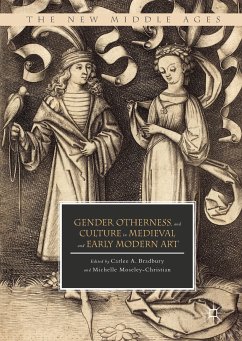This collection examines gender and Otherness other as tools to understand medieval and early modern art as products of their social environments. The essays, uniting a diverse array of up-and-coming and established scholars, explore both iconographic and stylistic similarities deployed to construct gender identity. The text analyzes a vast array of medieval artworks, including Dieric Bouts's Justice of Otto III, Albrecht Dürer's Feast of the Rose Garland, Rembrandt van Rijn's Naked Woman Seated on a Mound, and Renaissance-era transi tombs of French women to illuminate medieval and early modern ideas about gender identity, poverty, religion honor, virtue, sexuality, and motherhood, among others.
Dieser Download kann aus rechtlichen Gründen nur mit Rechnungsadresse in A, B, BG, CY, CZ, D, DK, EW, E, FIN, F, GR, HR, H, IRL, I, LT, L, LR, M, NL, PL, P, R, S, SLO, SK ausgeliefert werden.









